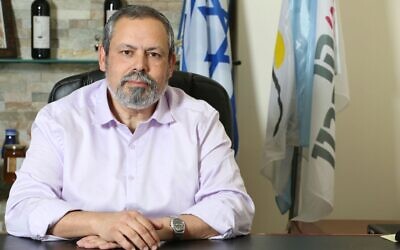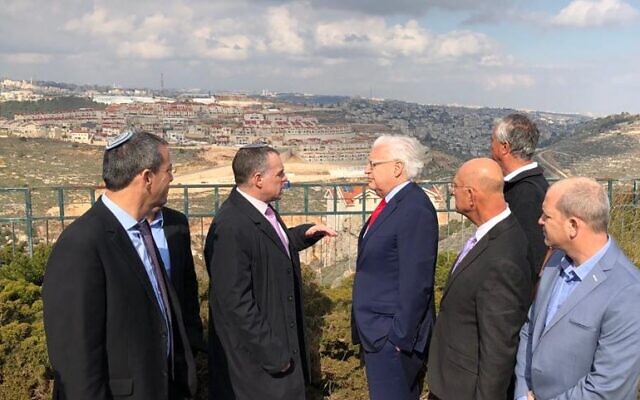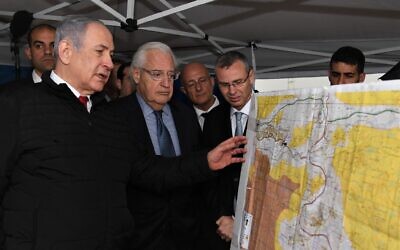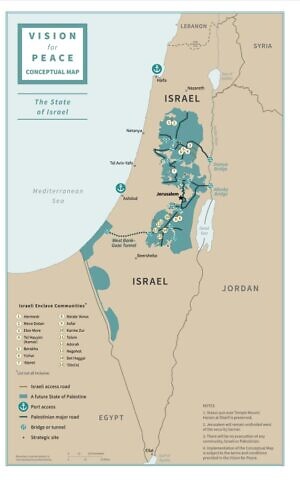
In effort to thwart deal, West Bank mayors lobby right-wing MKs with blown-up map showing proposal’s 15 envisioned enclave settlements surrounded by large red Palestinian state.
Settler leaders have been meeting with right-wing lawmakers over the past week and presenting them with what they claim is a map of the Palestinian state envisioned by the Trump plan, which would encircle 15 Israeli communities in a manner they say is unacceptable.
The Yesha umbrella council of West Bank mayors passed a resolution earlier this month declaring that it would not accept the Trump plan’s green-lighting of Israeli annexation of parts of the West Bank if it meant agreeing to the other key part of the proposal — the establishment of a Palestinian state.
In the weeks since, Yesha officials, including chairman David Elhayani, director Yigal Dilmoni and various West Bank mayors, have been sitting down with lawmakers from the Likud, Jewish Home and Yamina parties in an effort to convince them to oppose the Trump plan, for which Prime Minister Benjamin Netanyahu has voiced his support.
To their meetings with right-wing lawmakers in the Knesset, the Yesha officials have been coming equipped with a blown-up map showing what they claim is the Palestinian state envisioned by the Trump plan in red. The map highlights the 15 settlements that would become isolated enclaves encircled by the Palestinian state and also shows that many of the key highways running into and through the West Bank, such as routes 5 and 60, would no longer be accessible to Israeli drivers.
Elhayani, however, admitted to The Times of Israel that the map is based on the conceptual version that was presented by US President Donald Trump at the plan’s unveiling in January. The administration has warned both sides against taking that map as final, noting that a joint US-Israeli mapping committee has been tasked with outlining the exact contours of the areas Israel would be allowed to annex and those set aside for a future Palestinian state.
Nonetheless, Elhayani said, the mapping committee members have refused to meet with settler leaders to take their concerns into account and thus, he claimed, the map the US said was only conceptual will end up being the final version implemented.
The mapping committee is made up of Knesset Speaker Yariv Levin (Likud), National Security Adviser Meir Ben Shabbat, Prime Minister’s Office director Ronen Peretz, and Ambassador to the US Ron Dermer on the Israeli side; and Ambassador to Israel David Friedman, his adviser Aryeh Lightstone and the National Security Council’s Israel and Palestinian affairs director Scott Leith from the US side.
Har Hebron Regional Council chairman Yochai Damri, who accompanied Elhayani during several of the Knesset meetings, said that when Yesha officials approached Israeli members of the mapping committee earlier this month, they were told that the mapping was still in its early stages, but that “there was no chance” the American side would take into account their alteration requests.
Damri said that the conceptual map allows for Israeli sovereignty over 32 percent of the West Bank. Yesha was hoping to convince the committee to expand the figure to 38.5% in order to prevent the formation of isolated Israeli enclaves encircled by the future Palestinian state.
Damri said that the settler leaders would perhaps be willing to accept the 32% figure if the borders were redrawn to connect the enclaves to the rest of Israel. He added that he was prepared to give up sovereignty over a number of areas that the plan grants to Israel such as the West Bank coasts of the Dead Sea.
“This doesn’t have to be a zero-sum game. It’s possible to make this a win-win,” Damri asserted. “But the Israeli side of the mapping committee shut us out.”
The Times of Israel reached out to several members of the mapping committee for comment, but did not receive responses. The seven-member body has not spoken on the record regarding its efforts since being formed, beyond vague closed-door statements stating that progress is being made.

Damri, a resident of Otniel, which would be one of the plan’s 15 settlements-turned-enclaves, took particular issue with the plan’s “neglect” of such towns, which are home to roughly 5% of the 450,000 settlers in the West Bank.
“These are communities that underwent gruesome terror attacks, and now you’re telling them that they can’t develop and basically passing a decision that will lead to another disengagement,” he said, referring to the effects that will be felt by the enclave communities, which will be barred from expanding for a four-year period during which negotiations toward a final resolution with the Palestinians would take place.
He said he would be willing to support a building freeze in the areas surrounding Israeli settlements that are earmarked for a Palestinian state if the latter side holds to the freeze as well. If that is not to be the case, then the Israeli side could not accept such a requirement, he said.
Damri also dismissed the argument that those 15 communities and others would still be allowed to build upward, saying that’s not a realistic solution for settlements in his regional council. “The building plans don’t allow for such construction. We would have to completely change them — a process that takes three or four years.”
“The Har Hebron Regional Council sits on a million dunams. The only elevator in this entire area is located in my office,” he said.

Damri is a member of what appears to be a majority of the 24 settlement mayors who oppose the Trump plan and voted in favor of the Yesha Council resolution rejecting it earlier this month. Alongside that group, another camp has formed in recent months made up largely of mayors of towns closer to the Green Line, who insist that the Trump plan represents a once-in-a-lifetime opportunity for the settlement movement.
That latter group, which includes Efrat Mayor Oded Revivi, Ariel Mayor Eli Shaviro and at least six other council chairmen, has argued that while accepting the plan’s envisioning of a Palestinian state is a hard pill to swallow, the risk is mitigated because the Palestinian Authority is unlikely to accept the long list of conditions required in order to even enter negotiations for statehood.
The more moderate camp insists that Israel can ill afford to pass up an American green light for annexation, and that even if that means certain towns will have to become isolated enclaves, their situations will not be starkly different from today.
The opposing camp, which includes Damri, Elhayani and Samaria Regional Council chairman Yossi Dagan, is opposed in principle to the establishment of a Palestinian state, no matter how small and non-contiguous it might be.
Pressed as to why he opposed the plan’s envisioning of a Palestinian state when, under the deal, it wouldn’t be in control of its borders or have an army, Damri claimed this was the same rationale used during the Gaza disengagement, which ultimately led to Hamas’s takeover of the Strip.
“I have no problem with giving them greater municipal control in order to improve their day to day lives, but once you grant them a state, you can’t go back,” he said.

Damri recognized that the offer put forward by Trump may be the best one the US will ever be willing to present and that it may slide off the table completely after the November presidential election. However, he said he was prepared to forgo US support for annexation if the administration refused to take the Yesha Council’s requested alterations of the conceptual map into account.
“As of today, according to the Oslo Accords, 60% of [the West Bank] is under Israeli control. I prefer this current status over what’s presented in this plan,” Damri insisted. “We reached half a million residents under this current status and that was in the context of an international agreement.”
While he said applying Israeli sovereignty to his regional council and others in the West Bank was a worthy goal, he was prepared to pass on the opportunity rather than “put the residents of the plan’s created enclaves at risk.”
He noted that annexing the Golan Heights in 1982 did not prevent successive Israeli leaders, including Netanyahu, from negotiating its possible return to Syria.
(Times of Israel).
